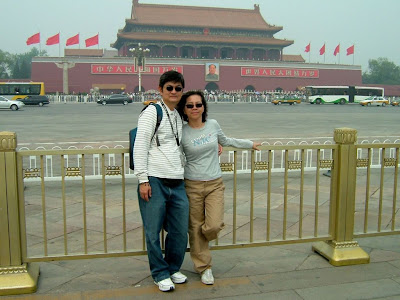

Watching the flag raising at Tienanmen Square (天安门升旗礼) is an incredible experience when you are in China. China National Flag is raised with the time for the sunrise. They time the flag raising up at the exact moment of sunrise. Each day has its different time for the ceremony.



Groups of soldiers of Guards of Honor came out through the gate of Tienanmen Tower south of Forbidden City. Shortly, Chinese National Anthem was being played when the soldiers ceremoniously attached the flag and slowly raised up. Majority of people are Chinese domestic tourists coming from all parts of China. They sang along with their National Anthem, deeply expressing their patriotic feeling towards their nation. The entire ceremony lasts for only 3 minutes.



In order to share, this not exactly important but interesting moment with the locals, we woke up at 4 am, walked 10 minutes in the dark from our hotel, queued up 30 minutes under rain and finally went through the tight security check point at Tiananmen Square. We witnessed the ceremony though we missed the glow of sunrise.


The police and soldiers began to leave the Square after the ceremony.



Some people came late and some were reluctant to leave after the ceremony.



Banquet decoration in Tiananmen to welcome its 18 National Congress of Communists Party opening in 8th November, 2012.




Though raining, there were thousands of people waking up at dawn just to witness this 3 minutes ceremony and experience the incredible moment.


Security is doubly tight as China's 18 National congress of Communists Party is on in the Great Hall of People at Tiananmen Square.


The magnetism of Tienanmen square is still as strong as when we visited in Olympic year 2008. This world famous and biggest square in China, with huge Mao-Ze-Dong's picture positioned at the central place, never loose its charm to attract millions and millions of tourists every year since the year China started its open-door policy for visitors in late 1970s.






Besides Forbidden City and The National Library, Mao-Ze-Dong's Mausoleum and The Great Hall of People are among some of the important structures, that lie within the areas of Tienanmen Square. In the center of the square, stand an outstanding square stone pillar plaque inscribed with Mao-Ze-Dong's phraseology in his hand writing..




Main City Gate of Beijing : Zheng Yang Men Tower (正阳门楼).



Wangfu-Jing
About 10 minutes walk from Tienanmen Square is one of the Chinese Capital most famous shopping street, Wangfu-Jing. The street starts from Nankou where Beijing Hotel, Oriental Plaza and Wangfu-Jing subway station north-exists are located, and ends at Xindong An Plaza after passing by Xinhua Bookstore, Beijing Departmental Store etc.



Wangfu-jing literally means Prince Mansion Well as after discovery of a well full of sweet water, there were ten aristocratic estates and princes residences were built here in Qing Dynasty. Commercial activities had been held in this place since mid Ming period. Previously it was also known as Morrison Street named after an Australian journalist George Ernes Morrison. Wangfu-Jing Street was opened to traffic in late 1990s and modified in 1999-2000 making majority of the main shopping area pedestrianized.



Wangfu-Jing Pedestrian Street, being one of the traditional downtown area in Beijing is home to 280 famous Beijing Brand.



No one will ever miss the Peking Duck when coming to The Capital of China. Quanjide is the most popular duck shop in Beijing, dating back to more than 100 years of history. It is quite costly to dine in this kind of classic and historic brand restaurant. Half duck with sauce and wrapper was chargeable at about 150rmb. A lunch for two, we paid 254rmb.



The roasted duck was sliced piece by piece, part by part by the chef, done in front of the guests.



This is a proper way to eat Peking Duck, as demonstrated by the server.




The duck feet skin salad, the duck breast crispy skin and chestnut soup.



Specified Wood was used to roast the duck in a traditional kiln, in a glass-walled room. The process was done in transparency in front of its guests.


The duck was roasted upon order and served direct from the kiln.




Comparatively, we paid 50% less than the duck meal, for this wonderful dinner which consists of Sour fish soup, shrimp and sizzling local fermented bean curd.



We love Beijing zhajiang-mian though they are not exactly the same taste in different shops. The regular price of a large bowl zhajiang-mian was 10rmb.



There is a snack street in the hutong at west side of Wangfu-Jing Street, densely packed with restaurants and street food stalls.



Wide variety of common and exotic street food are served from the stalls.



Stewed stuffed eggs



Some rice cake and fried platter.



I loved this typical Beijing desert. The locals name it "Rolling mule". It is a kind of "mochi" making from glutinous rice with red bean.


The clams and snails


Towards northern side of Wangfu-Jing Street, there are also many night food stalls selling Muslim food and Xinjiang cuisine.



No comments:
Post a Comment